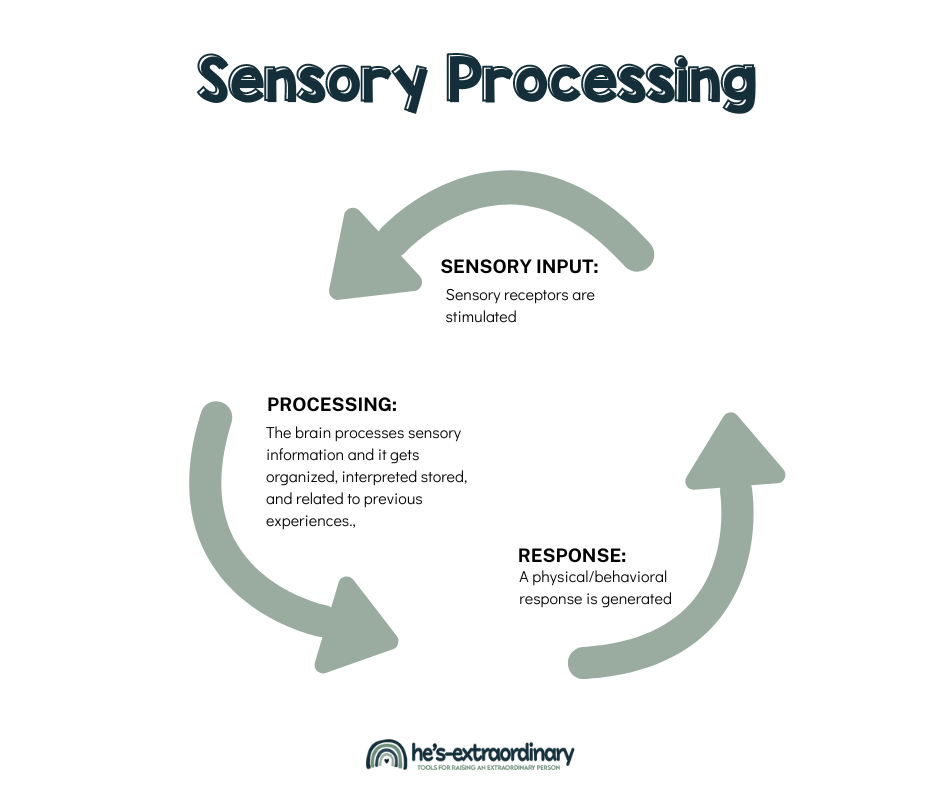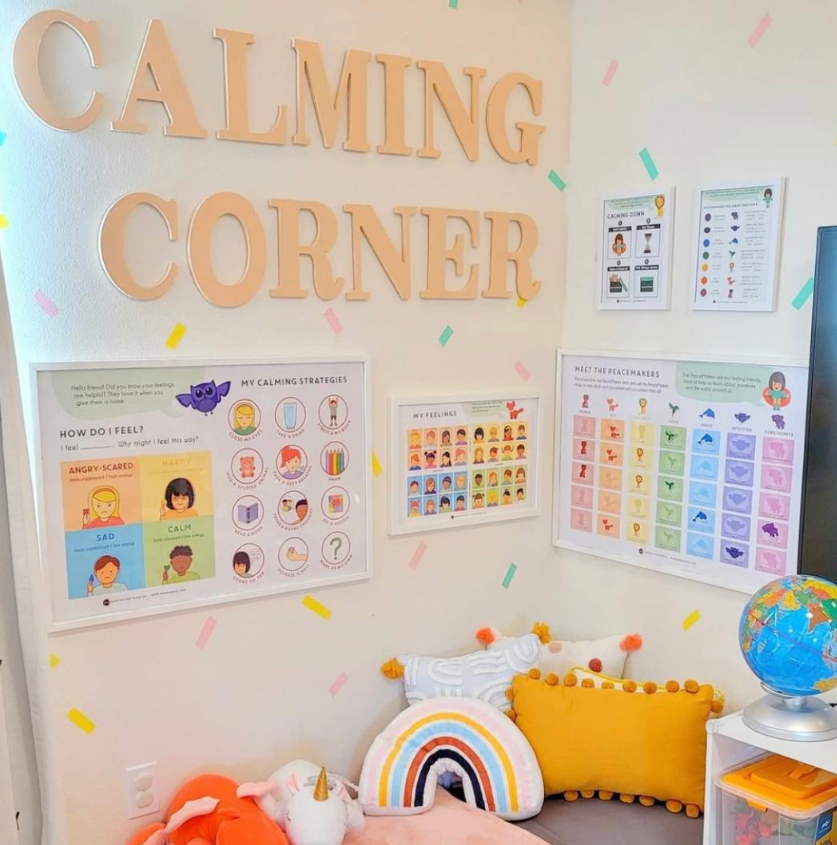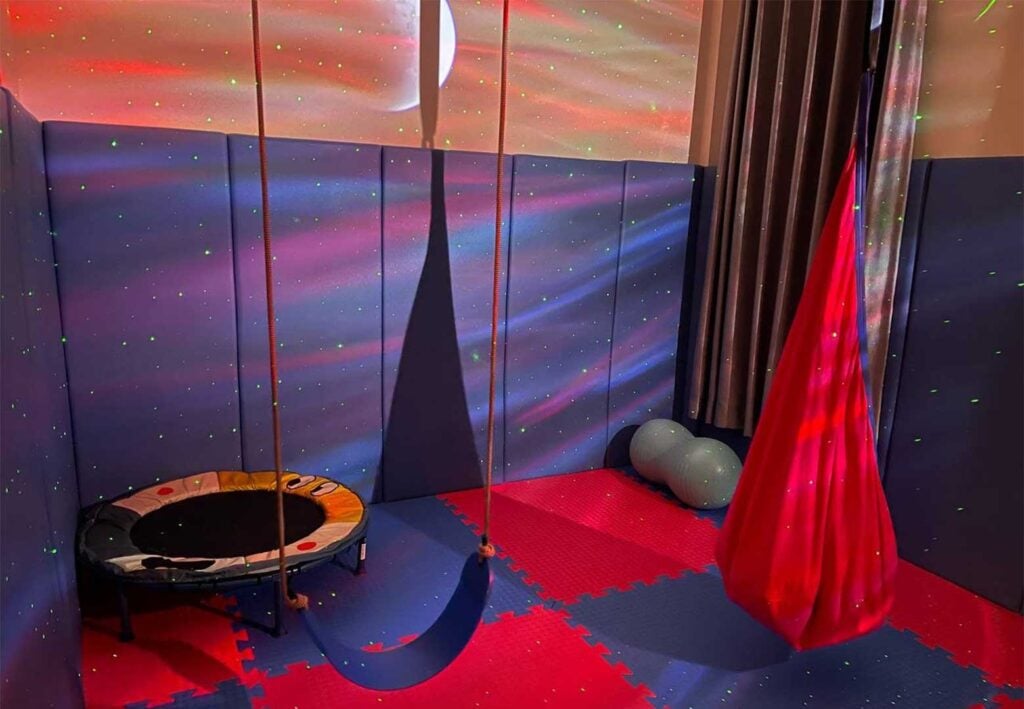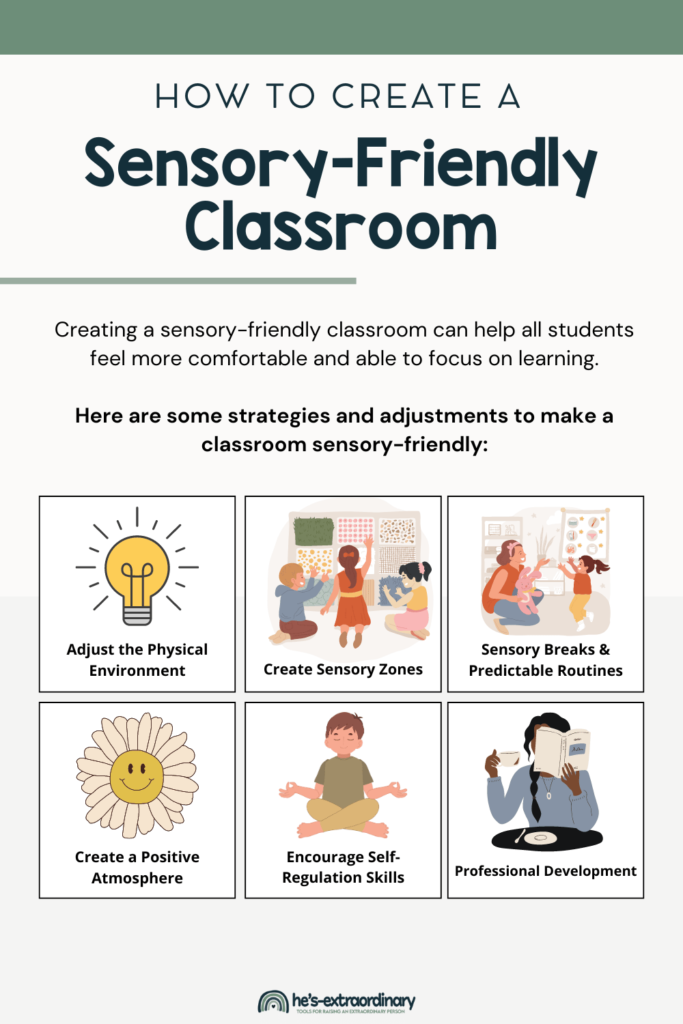How to Create a Sensory-Friendly Classroom: An In-Depth Guide for Educators
What’s inside this article: An in-depth guide designed to help teachers understand, recognize, and support sensory processing differences through the development of a sensory-friendly classroom using environmental modifications, sensory tools and equipment, and social-emotional education. This guide will help teachers make a sensory-friendly classroom where all students feel safe, comfortable, and ready to learn.
Disclaimer: This article contains affiliate links.
Would you be surprised to know that 1 in 6 children are neurodivergent?
According to the CDC, 17% (or 1 in 6) of children aged 3-17 in the United States have a diagnosis that is associated with sensory differences and neurodivergent traits.
For these kids, sensory experiences—like noise, light, textures, and movement—can feel more intense, less noticeable, or just different from what others might expect.
Because of this, many benefit from sensory supports in school to help them stay focused, regulated, and ready to learn.
What Are Sensory Processing Differences?
Sensory processing is how the brain and nervous system take in information from the senses and interpret it to guide movement, behavior, and reactions to the world around us.
Everyone processes sensory input differently. Some people experience sensations more intensely than others; some experience them less intensely. And for others, it’s just different.
All these variations influence how a person moves, focuses, interacts, and feels.

Sensory processing challenges occur when the brain processes sensory input in a way that interferes with daily activities.
These show up in many different ways. depending on how the individual is impacted. Some people may be highly sensitive to sounds, lights, or textures, while others may not notice certain sensations as easily. They might not register light touches, be less aware of where their body is in space, or seek more movement and sensory input to feel regulated.
Sensory processing is important because it plays a key role in cognitive development, communication, self-regulation, motor skills, and interactions with the environment.
Types of Sensory Processing Differences
Sensory processing differences can show up in a variety of ways, and a child may experience multiple types at the same time. For example, they might avoid certain textures and sounds while actively seeking movement and deep pressure.
The main ways sensory processing can differ include:
- Sensory Modulation—The brain processes sensory input in a way that makes it feel more intense (hypersensitive) or less noticeable (hypo-sensitive). This can affect how a person responds to sounds, lights, textures, movement, and other sensory experiences.
- Sensory Discrimination and Perception—The brain has difficulty distinguishing or making sense of sensory input. This can affect skills like recognizing the difference between textures, sensing where the body is in space, or interpreting sounds and touch accurately.
- Vestibular Bilateral Coordination— The vestibular system, which helps with balance and movement, may process input in a way that affects coordination between both sides of the body (bilateral coordination). This can impact activities like climbing, running, or using both hands together for tasks.
- Praxis and Motor Planning— Praxis refers to the brain’s ability to plan and carry out movements. When sensory processing affects motor planning, a person may need extra time or practice to figure out how to move their body in new ways, such as learning a new dance move or tying their shoes.
Behaviors Related to Sensory Differences
Sensory processing can impact a wide range of behaviors because it impacts how somebody experiences their environment and everything in it.
Sometimes, these behaviors can be misinterpreted by adults as defiance, inattention, or aggression when they are actually responses to sensory needs—either seeking more input or trying to reduce overwhelming sensations (sensory overload).
If you change the lens you use to view challenging behavior and try a new approach to addressing it, such as by meeting sensory needs; you can help kids feel more regulated, focused, and safe, making them better equipped for learning.
In fact, this case study found that sensory interventions can reduce classroom disruptions by 30%, benefiting all students.
You can learn more about sensory processing disorders here.
So, what type of behaviors may be related to sensory processing challenges?
Behaviors associated with sensory differences include
Sensory Avoidance (Hypersensitivity)
Hypersensitivity means sensory input feels too intense and too overwhelming. This can lead to discomfort, distress, avoidance, and sensory overload.
- Has a strong response to light touch, such as finding a gentle pat on the back uncomfortable or painful.
- Avoids certain textures, like sand, finger paint, or sticky substances.
- Is selective about clothing, disliking tags, seams, or certain fabrics, and may prefer wearing the same comfortable items daily.
- Finds large crowds overwhelming and may prefer quieter, less stimulating environments.
- May find hair brushing, washing, drying, or cutting uncomfortable due to the sensation on their scalp.
- Has strong food preferences and may stick to a small number of familiar, safe foods.
- Covers ears, shields eyes, or hides their face in response to loud sounds, bright lights, or visual clutter.
- Has intense reactions to internal sensations, such as hunger, thirst, or the need to use the bathroom, which may feel urgent or even painful.
- Finds it difficult to focus in stimulating environments, especially when background noise, visual distractions, or other sensory input compete for attention.
- Feels anxious or uneasy in certain places, situations, or activities due to sensory unpredictability.
- Frequently experiences nausea, especially in response to motion or sensory input like strong smells.
- May be hesitant or uncomfortable with playground equipment like slides, swings, or merry-go-rounds.
- Prefers to avoid elevators or escalators due to how they feel in motion.
- Prefers low-movement activities and may avoid physically intense experiences.
- Worries about stability or balance, even in situations where falling isn’t a major risk.
- May feel unsure about using stairs or walking on uneven surfaces.
- Prefers to keep their feet on the ground and may avoid activities like jumping or climbing.
- Startles when touched or moved unexpectedly, such as when someone pushes their chair in.
- Notices and is bothered by small sounds (e.g., a ticking clock, dripping faucet) that others might not register.
- Finds public restrooms overwhelming due to loud sounds like flushing toilets and hand dryers.
When unable to avoid overwhelming sensory input, a person may experience sensory overload, which can lead to:
- A meltdown (a visible stress response such as crying, yelling, or seeking space).
- A shutdown (withdrawing, zoning out, or becoming unresponsive).
Hyposensitivity
Sensory Seeking
Hyposensitivity means some sensory input feels muted or less noticeable. When this is the case, some may actively seek out sensory experiences —such as movement, deep pressure, or intense flavors— to get the sensory input their nervous system needs.
Sometimes, kids choose actions to meet those needs, like constantly fidgeting or roughhousing or making a lot of noise that is distracting or bothersome to others. That’s not because the kids are “bad” but because they’re meeting a sensory need in the best way they know how.
We can often address this by providing alternatives that support their sensory needs effectively.
Low Registration
Low registration is a form of hyposensitivity where sensory input feels muted and less noticeable, but the individual does not actively seek additional input.
Instead, they may seem passive, disengaged, or unaware because their nervous system isn’t picking up on sensory cues as readily. So, a child with low registration might not realize when they’re hungry or thirsty until it becomes urgent or be slow to respond, but not because they’re inattentive, but because their brain processes input at a different pace.
Behaviors associated with Hyposensitivity
- Regularly seeks tactile input, touching objects, rubbing textures against their skin, or exploring items with their mouth (e.g., licking or chewing).
- Enjoys strong flavors, such as spicy, salty, sour, or intensely sweet foods.
- Has a high pain threshold, sometimes not reacting to injuries or discomfort.
- Doesn’t always register light touch, needing firmer pressure to notice physical contact.
- May not realize when their face is dirty or when they have a runny nose.
- Engages in repetitive or deep pressure movements, such as squeezing, pinching, or tapping.
- May not notice temperature extremes, wearing light clothing in cold weather, or not reacting to heat.
- Uses a loud voice naturally, preferring high-volume environments.
- Creates sound or movement for self-regulation, such as humming, tapping, making vocal noises, or drumming fingers.
- Seeks consistent background noise, like keeping a fan running for comfort.
- May not always respond to verbal cues, such as their name being called or school bells ringing.
- Finds it challenging to remain still, frequently shifting, fidgeting, or moving around.
- Moves with strong force, sometimes bumping into people, walls, or objects without realizing it.
- Seeks deep pressure input, enjoying firm hugs, weighted blankets, or squeezing sensations.
- Prefers high-energy movement, such as jumping, running, climbing, or hanging upside down.
- Chews on clothing, pencils, or other objects as a form of sensory input.
- Takes longer to recognize internal body cues, such as needing the restroom, feeling hungry, or knowing when they are full.
- Enjoys spinning and rarely gets dizzy, seeking activities like amusement park rides or twirling in a chair.
- Loves swings, slides, and other movement-based activities, often craving these experiences for regulation.
If a person is unable to get the sensory input they need—whether through movement, stimming, or other self-regulating strategies—they may experience sensory distress, which can lead to:
- A meltdown (a visible stress response such as crying, frustration, or seeking movement to regulate).
- A shutdown (withdrawing, zoning out, or becoming unresponsive).
Providing opportunities for safe sensory input—such as movement breaks, access to fidgets, and sensory-friendly tools—can help meet these needs and support regulation in a way that feels comfortable for the individual.
Benefits of Sensory-Friendly Classrooms
Sensory differences impact so many children, and the behaviors that go hand-in-hand with these differences often impact the entire classroom. Even neurotypical children can become over- or under-stimulated. This is called sensory mismatch.
Looking over this long list of behaviors, you can see why building a sensory-friendly classroom with tools and equipment available to support all sensory needs is so essential.
Research and case study findings show that sensory-friendly learning environments can:
- Reduce classroom disruptions: Classrooms and schools equipped with sensory tools and equipment report fewer behavioral incidents. Sensory equipment helps mitigate under- and over-stimulation, common causes of disruptive behavior. Research indicates that sensory interventions can reduce classroom disruptions by up to 30%, creating a more conducive learning environment for all students.
- Improve focus and academic performance: Sensory equipment helps students self-regulate their sensory needs, allowing for better focus and participation in academic activities. A study indicated that students who used sensory integration strategies showed a 25% improvement in task completion and a 15% increase in test scores.
- Emotional Development: Sensory equipment and tools help children develop the ability to manage emotions and behaviors in response to external demands by teaching them to calm down and cope with sensory overload or under-stimulation in healthy ways.
- Social Development: Sensorily balanced children feel less anxious, which makes them more likely to engage in positive social interactions. Sensory equipment and tools can also encourage cooperative play and help kids build peer relationships.
- Cognitive Development: Sensory integration activities are linked to improvements in cognitive processing, aiding in the development of complex executive functioning skills like working memory, task initiation, problem-solving, and organization.
- Sensory Development: Regular access to sensory tools and equipment helps students with sensory integration differences better process the sensory information they perceive, which is crucial for academic performance and cognitive development.
Physical Benefits
A sensory-friendly classroom also provides a wide range of physical health benefits to children:
- Fine motor skill development: Developing these skills is crucial for tasks such as writing, drawing, and cutting with scissors.
- Gross motor skill development: Students with strong gross motor skills are more likely to participate in physical education and recess activities, promoting a healthy lifestyle and enhancing social interactions.
- Improved core strength: A strong core helps students maintain proper posture while sitting and standing, which is crucial for extended periods spent in classrooms.
- Improved coordination and balance: Students who excel in these areas are often more confident and active participants in physical education classes.
Finally, building a sensory-friendly classroom (and school) increases inclusivity and accessibility.
You can better address current and future education challenges and raise a generation of students who are better supported and more accepting, empathetic, compassionate, and understanding of others.

How to Build a Sensory-Friendly Classroom
Creating a sensory-friendly classroom can help all students feel more comfortable and able to focus on learning.
Here are some strategies and adjustments to make a classroom sensory-friendly:
1. Adjust the Physical Environment
Lighting
Use Natural Light: Maximize natural light by opening blinds or curtains. If artificial lighting is needed, choose soft, warm lights instead of harsh fluorescent lights.
Lamps and string lights can provide soft lighting that doesn’t overstimulate.
Fluorescent Light Covers: If fluorescent lights are the only option, use covers to soften and diffuse the lights. This can help reduce eyestrain and discomfort; however, some students may notice noise and flickering still coming from the lights, even when covered.
Dimmer Switches: Install dimmer switches so you can adjust lighting levels based on students’ needs and activities.
Sound Control
Sound-Absorbing Materials: Carpets, rugs, curtains, and soft furnishings absorb sound and reduce echo. Consider acoustic panels on the walls and ceiling.
White Noise Machines: Use a white noise machine or soft background music to mask distracting noises. Noise-canceling headphones or earplugs can also help students with sound sensitivities. These tools should always be visible and accessible to all students without needing to ask the teacher for permission first.
Acoustic Dividers: Freestanding acoustic desk dividers can provide students with noise reduction and provide additional privacy. Larger portable panels can partition off areas in the classroom.
Visual Supports
Visual supports help provide the structure and predictability children need, reducing anxiety and promoting independence.
They also help keep the classroom clean and organized. Visual clutter can be overstimulating, especially for hypersensitive children (and adults!).
When choosing visual supports, use calming colors and simple, non-distracting visuals to create a more soothing atmosphere that reduces visual overstimulation. Avoid bright, overly stimulating colors.
Clear Signage: Use clear, simple signs and labels (with pictures) for different areas and materials in the classroom. Visual schedules can help students anticipate transitions and activities.
Visual Schedules: Visual schedules help provide stability and predictability, promote independence, and help children build healthy constructive habits. You can find various examples of visual schedules here.
2. Create Sensory Zones
Sensory zones are designated areas created to support different types of sensory needs. By creating zones, children can have a space to go if they are overstimulated or understimulated.
Calming Corner
Create a dedicated space where students can retreat when they feel overwhelmed or overstimulated. This is a calming area for self-regulation.
Comfortable seating, soft lighting, and calming tools, such as prompts for deep breathing exercises, weighted items, or sensory tools, should be included.
Read: How to Make the Ultimate Calming Corner.

Active Zone
This is a designated space for children who are sensory-seeking or who just feel like they need some extra movement.
Include sensory-motor equipment that allows children to safely meet their sensory needs in ways that are not disruptive to the rest of the classroom—for example, access to a small trampoline, a sensory swing, or a crash pad.
The experts at SensoryRX can provide personalized advice on the right equipment for your needs, space, and budget.
There may also be grants or funding available to cover equipment costs.

Flexible Seating
Provide different seating options to accommodate various sensory preferences, such as:

3. Incorporate Sensory Breaks
Types of Breaks
- Scheduled Breaks at Regular Intervals: Integrate sensory breaks throughout the day, giving students time to participate in activities like stretching, deep breathing, exercises, or using sensory tools. Occupational therapists often recommend short (5-10 minutes) but frequent (everyone 1-2 hours) breaks for sensory activities, sometimes called sensory snacks. This is more effective than taking longer sensory breaks in less frequent intervals.
- Movement Opportunities: Allow for movement breaks that involve activities like walking, jumping, or simple exercises to help regulate energy levels—for example, this 7-minute HIIT workout for kids.
- Sensory Tools: Provide various sensory tools, like fidgets and stress balls, that students can use to help them stay focused and manage sensory input while focusing on academic expectations, too. Keep these readily available so students can access them without requesting permission.
4. Predictable Routines
Maintain a consistent daily routine to provide students with both the security and predictability they need. Unlike adults, children’s brains are still developing, especially the prefrontal cortex, which is responsible for executive functions. This is where the ability to plan ahead and make predictions happens.
Children can’t do this accurately simply because their brains haven’t yet developed that skill. So, they depend on structure and routine.
Uncertainty is a major cause of anxiety, especially for neurodivergent children. A highly predictable routine helps kids feel secure, know what to expect, and practice making simple predictions. This helps them feel regulated and more focused.
Minimizing anxiety and other potential triggers or stressors for children means they’re more likely to tolerate stimuli and more likely to be able to self-regulate in the classroom.
5. Create a Positive Atmosphere
- Encouragement and Praise: Use positive reinforcement to encourage appropriate sensory-seeking behaviors or self-regulation strategies, as well as participation in classroom activities.
- Personalize Learning Spaces: Set up individual workstations with minimal distractions for students who need a quiet space to focus. Find more tips here: Differentiation in the Classroom.
- Personalized Sensory Kits: Create personal sensory kits for students containing items that help them self-regulate, such as noise-canceling headphones, weighted lap pads, or chewable jewelry. Build these kids based on their individual sensory preferences.
6. Engage in Professional Development
- Sensory Processing Education: Schools should provide educators and support staff training on sensory processing and strategies for both recognizing and supporting students with additional sensory needs.
- Collaboration with Specialists: Collaborate with occupational therapists to design and implement sensory-friendly strategies in the classroom.
- Self-Education: Learn more about sensory processing and neuroaffirmative, inclusive classroom strategies by doing research online, reading books, and watching videos from experts in the field so you can stay up-to-date on knowledge and best practices.
7. Encourage Self-Regulation Skills
Sensory regulation and emotional regulation are deeply connected. Meeting sensory needs helps children feel safe and regulated, making it easier to regulate emotions.
Self-regulation is not about suppressing emotions—it’s about recognizing, understanding, and responding to them in ways that support well-being.
Lots of people use sensory-based coping strategies to manage their emotions. For example, a child might rock back and forth (a form of sensory regulation) to soothe themselves when feeling anxious (emotional regulation).
Self-regulation begins developing in early childhood and continues throughout life, evolving into more complex emotional and social skills.
While some children intuitively develop these skills, neurodivergent children often benefit from explicit teaching and structured support. Social-emotional learning programs, such as The Zones of Regulation, can be helpful tools for exploring and practicing self-regulation.
Key Skills for Self-Regulation
- Recognizing and Naming Emotions: Teach children how to identify emotions and what those emotions feel like in their bodies. Try this: How Do I Feel? Activity Book
- Identifying triggers: Help children notice what situations, environments, or interactions tend to cause distress or dysregulation. Understanding why certain triggers affect them is an important step in self-advocacy.
- Exploring Coping Strategies: Everyone benefits from a variety of sensory and emotional regulation strategies. Rather than imposing specific techniques, it’s important to offer a range of options and allow children to explore what feels best for them. Try exploring different mindfulness activities and relaxation techniques and help them choose their preferred strategies.
- Communicating emotions: Support children in expressing their feelings in ways that feel comfortable for them. Some may prefer verbal communication, while others may use visuals, gestures, or other alternative communication methods. Emotion coaching can be a great tool to help children articulate what they’re feeling and why.
Why Sensory and Emotional Regulation Go Hand-in-Hand
When sensory needs aren’t met, emotional regulation becomes more difficult. Sensory overload or under-stimulation can contribute to anxiety, frustration, distress, or meltdowns.
Both sensory and emotional regulation involve the autonomic nervous system. Overstimulation of the sensory system can activate the body’s stress response—sometimes known as the fight-or-flight response—making it harder to manage emotions.
By recognizing the connection between sensory and emotional regulation, we can create environments that support both, helping children feel safe, understood, and able to engage in learning and social interactions with greater ease.
The Understanding and Coping with Feelings Mega Bundle offers a wide range of educational tools to help you help children develop these crucial skills.

Creating a sensory-friendly classroom not only improves academic performance and reduces disruptions. It also improves social-emotional development, makes learning environments more inclusive and accepting, and helps all students feel more comfortable and ready to learn.
Teachers can create a sensory-friendly classroom by making just a few changes: adjusting the physical environment, creating sensory zones, providing predictability, creating a positive atmosphere, and teaching emotional regulation skills.

